Ah, the summer game: baseball. One of America’s most beloved pastimes, woven with nostalgia, tradition, and cheering crowds. Among those who love the game, you’re certain to find physicists. And it makes sense: Baseball is as much about timing and torque as it is about tradition and teamwork. Beneath every swing and curveball lies a world of motion, energy, and finely tuned mechanics that would pique the interest of any curious mind.
This month, I’ve teamed up with AIP’s resident baseball enthusiast Frank Graeff from the AIP Federation Team and our dedicated team of librarians to share a few gems from our archives: photos of physicists at play! Some are known for their contributions to baseball physics, while others simply offer a glimpse into the human side of science in the 20th century.
Of course, we couldn’t include everyone here, so if you’d like to explore more moments like these, or submit your own photos to our collection, visit the Emilio Segrè Visual Archives for a deeper dive into the history of physicists in motion — on and off the field.
Thomas Edison
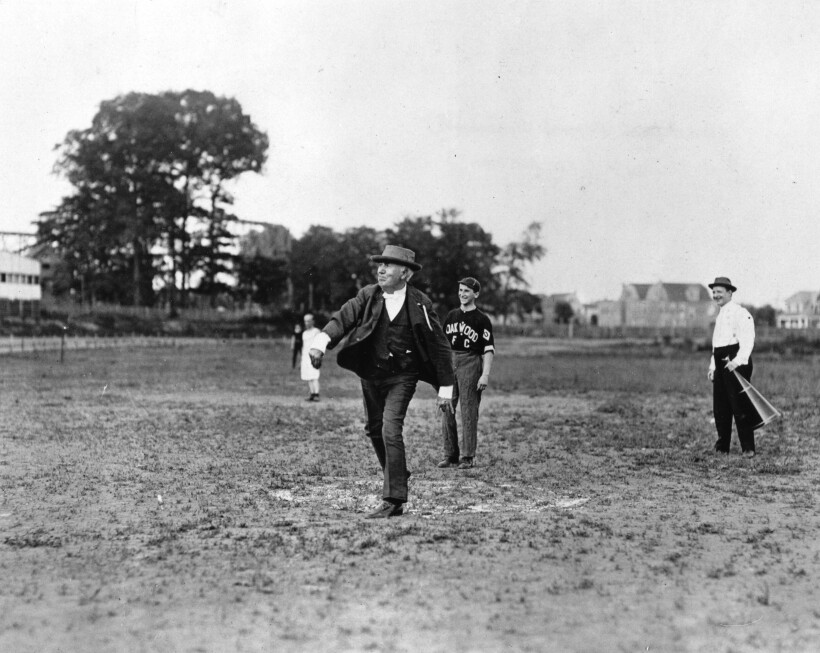
Thomas Edison during a game of baseball.
Photograph by W. F. Meggers, courtesy AIP Emilio Segrè Visual Archives, W. F. Meggers Collection. Edison Thomas B1 .
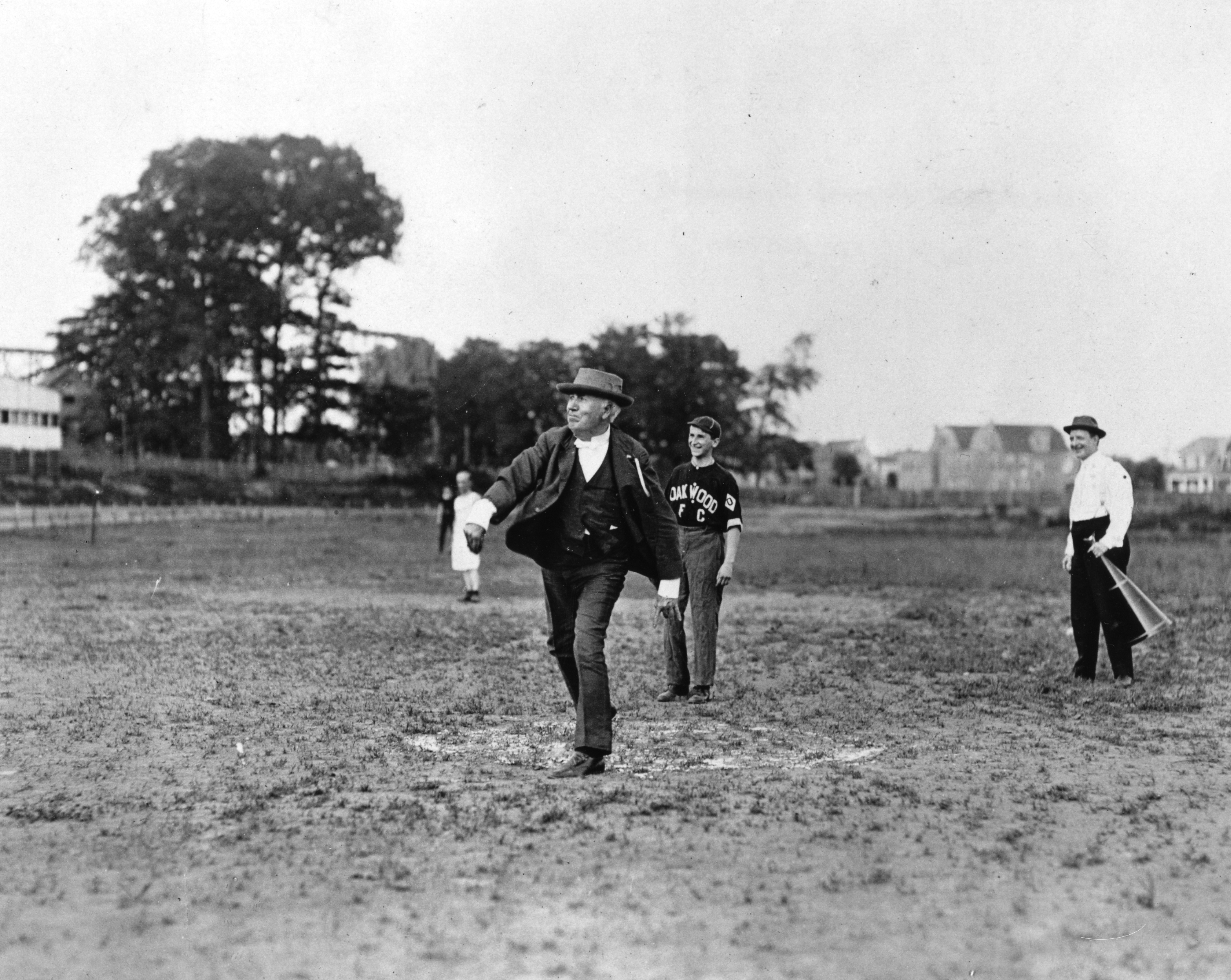
Thomas Edison’s love for baseball was well documented. In fact, some of this documentation he did himself: He was among the first to film a baseball game, and you can watch that archival film — from 1898! — over at the Library of Congress . Several sources describe Edison as a die-hard baseball fan who regularly visited spring training at Terry Park in Fort Myers, Florida, including an occasion in March 1927 where he joined in a batting practice session for the Philadelphia Atheletics with baseball legend Ty Cobb. According to an Associated Press account in the Evening Star , Edison— introduced as “the white wizard” with “some fame in the Invention League”— was escorted to the plate by manager Connie Mack and handed a bat. Facing the pitches of Ty Cobb, Edison hit the first ball straight back at the Hall of Famer. The article recounts, “before the astonished Ty could lift a hand the ball hit him on the shoulder and rolled him over in the dust.” Allegedly, as photographers snapped away, and fans shouted “Sign him up!” Edison quipped to Cobb, “Think you will be able to do that when you’re 80?”
Hideki Yukawa
When I came across this photo of Nobel Prize–winning physicist Hideki Yukawa in a batting stance, I needed to know: Was this a one-off moment, or did baseball play a regular role in his life? A little digging led me to a memorial website hosted by Osaka University , which shares recollections of Yukawa’s daily routine during his early career. It turns out baseball was part of that rhythm — he was known to practice in the afternoons before heading home to Nishinomiya. The memorial notes that during this stretch of life in the 1930s, while he was discussing ideas with colleagues and practicing baseball, Yukawa was developing the research that would lead to his proposal of the π meson.
Baseball: found at the scene of discovery.
Sidney Dancoff
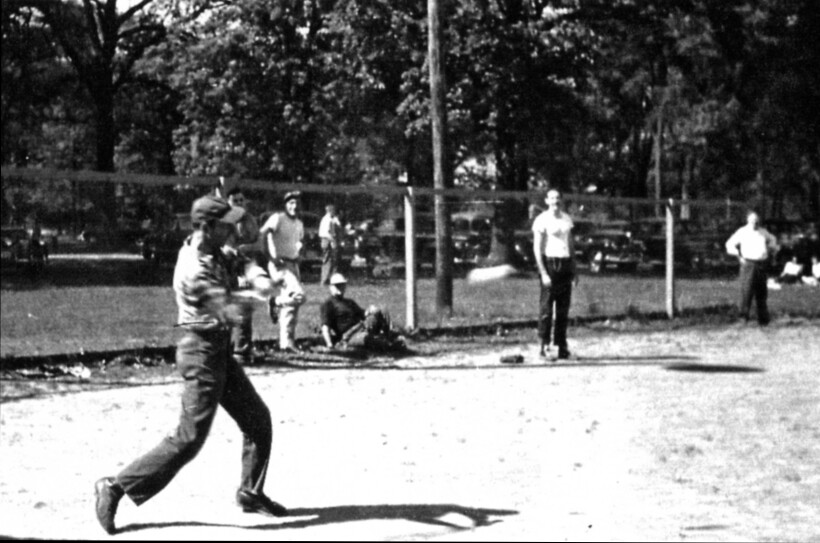
Sid Dancoff at bat, Sid Drell leaning (standing) on fence, Arnold Nordsieck on other side of fence at a University of Illinois Physics Department picnic.
AIP Emilio Segrè Visual Archives. Dancoff Sidney D2 .
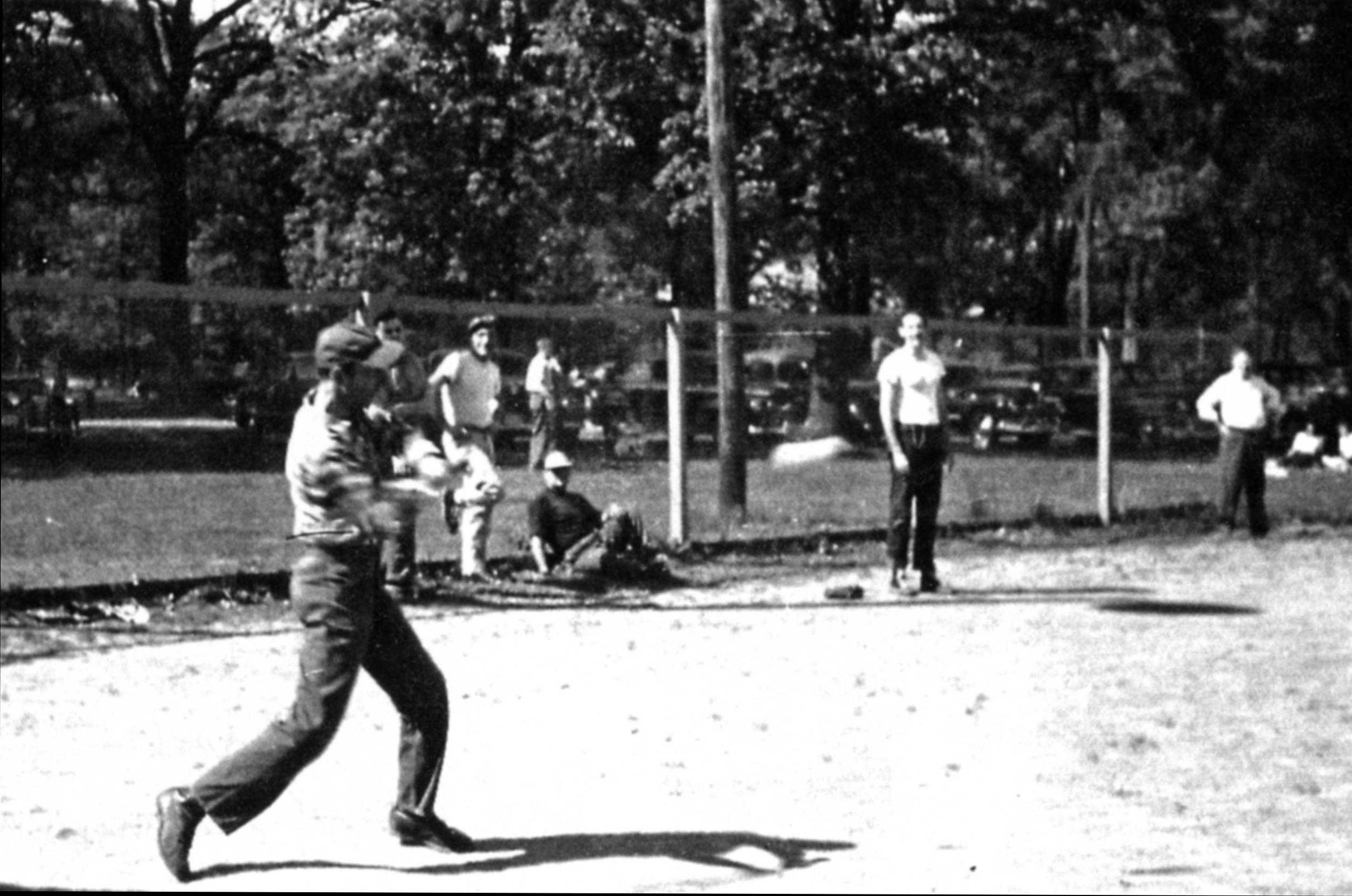
This archival image offers a rare glimpse of Sidney “Sid” Dancoff, a physicist whose career, though tragically brief, left a lasting mark on the field. A student of J. Robert Oppenheimer, Dancoff was part of an elite inner circle of graduate students who were close to their mentor. His research into quantum electrodynamics calculations, guided by Oppenheimer before World War II, later influenced work that earned Sin-Itiro Tomonaga a Nobel Prize . During the war, Dancoff contributed to the Manhattan Project, and afterward turned to nuclear reactor theory, developing the factor named for him and co-developing the Tamm-Dancoff approximation.
I scoured the oral history collection for mentions of Dancoff (and baseball, fwiw) and found that colleagues remembered him as an exceptionally bright and well-liked figure who also — due to his proximity to Oppenheimer — inspired professional envy. He was said to have had an adventurous side; in a 1988 oral history interview , Nobel laureate Philip W. Anderson recalled Dancoff joining the “Saturday Hikers,” a group of scientists and friends who explored the Illinois countryside. His life was cut short when he died of lymphoma at just 37 in 1951, but his work remains part of the scientific record, a testament to the impact one can make in a short time.
Wolfgang “Pief” Panofsky

Wolfgang Panofsky at the Annual physicists baseball game, played between the experimentalists (2nd floor) and the theoriticians (3rd floor including Director’s office).
AIP Emilio Segrè Visual Archives, Panofsky Collection. Panofsky Wolfgang D4 .
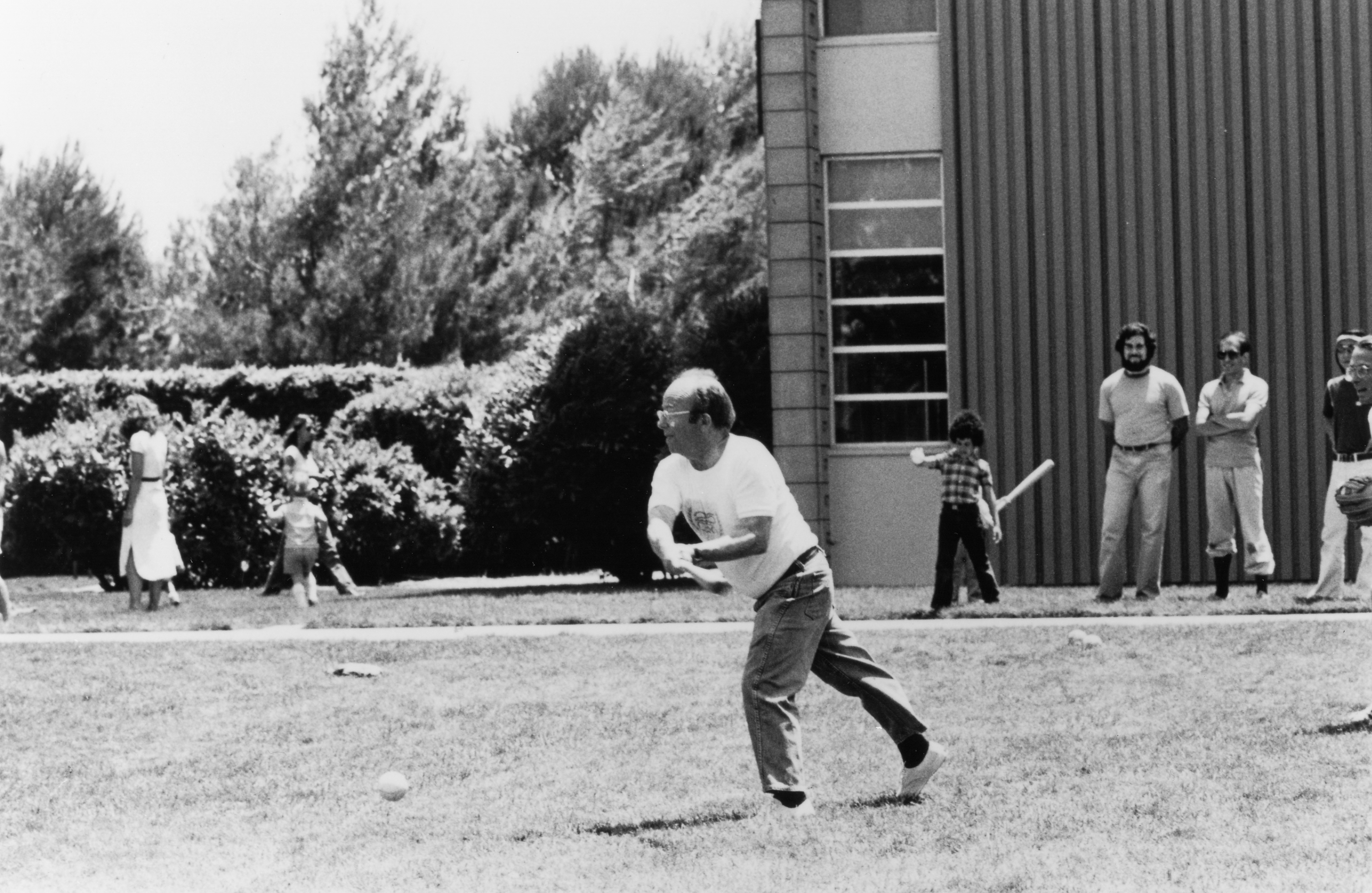
Captured here during SLAC National Accelerator Laboratory’s annual baseball game between experimentalists and theorists, Wolfgang “Pief” Panofsky embodied the spirit of collaboration and friendly rivalry . Born in Berlin in 1919, Panofsky emigrated to the United States in the 1930s and earned his Ph.D. at Caltech. During World War II, he contributed to radar development, and in the decades that followed became a central figure in U.S. high-energy physics, serving as president of the American Physical Society in 1974 and director of the Stanford Linear Accelerator Center (SLAC) from 1961 to 1984. Panofsky maintained a close friendship with fellow Oppenheimer grad student Melba Phillips, another notable physicist and future American Association of Physics Teachers (AAPT) Hall of Famer, according to Physics Today .
Known for his quick wit and even quicker swing on scientific problems, Panofsky was remembered both as a leading physicist and a tireless advocate for arms control with the Bulletin of the Atomic Scientists. While this image shows him enjoying some friendly competition on the field, his influence on particle physics — and the role of science in diplomacy — was anything but casual.
Lyman Briggs

Lyman Briggs (left) and William Swann (right) holding equipment at National Geographical strasophere flight
AIP Emilio Segrè Visual Archives, Physics Today Collection. Swann William C6 .
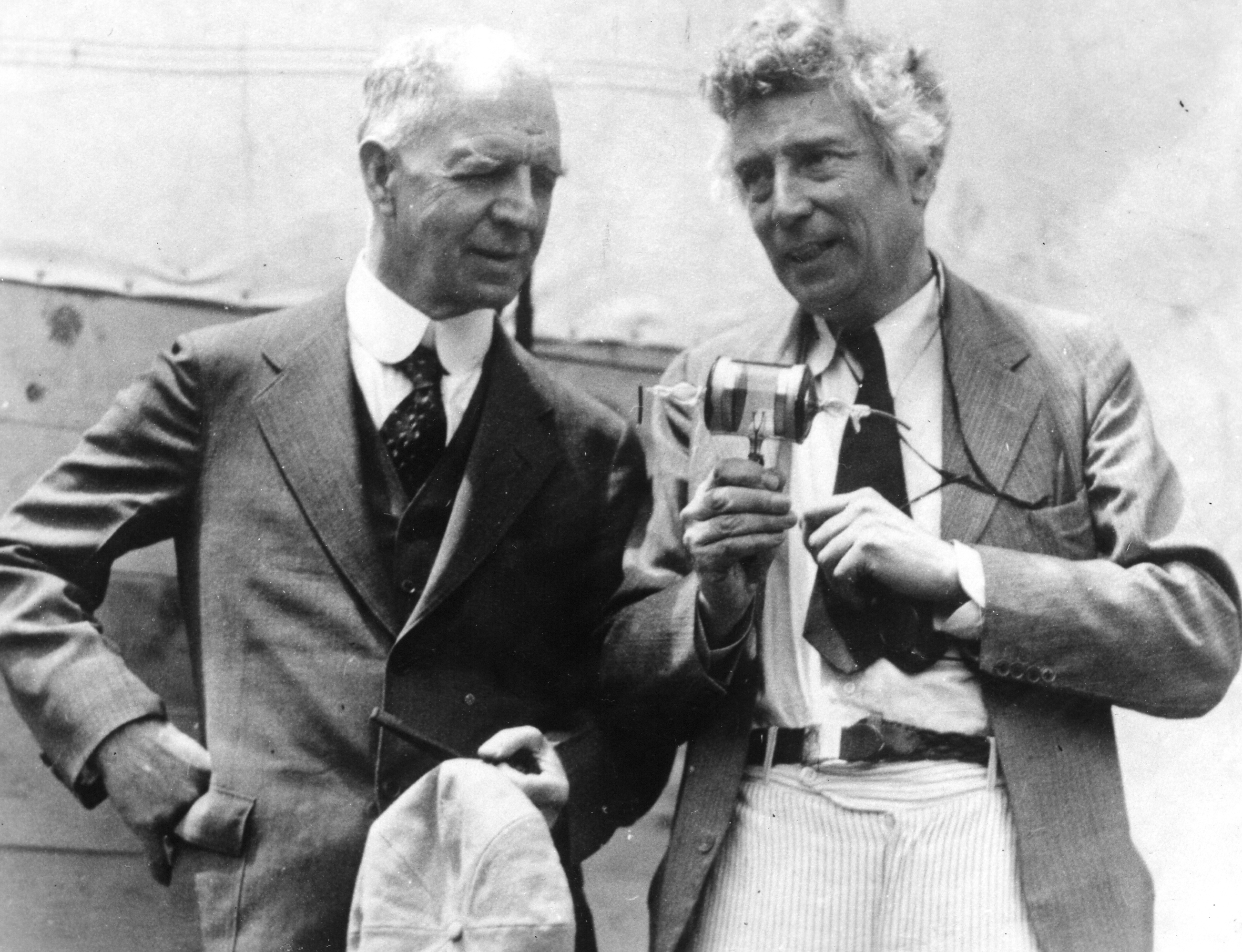
The third director of the National Bureau of Standards (now NIST) during the Great Depression with deep connections across federal agencies, Lyman Briggs was a scientist whose love for baseball sparked research that made headlines. During World War II, when the government required that the rubber in baseballs be replaced with cork due to rationing, widespread complaints about the new balls led him to investigate. In 1945, using a wind tunnel he designed, and with help from two Washington Senators pitchers, Briggs tested the effect of spin and speed on a baseball’s trajectory, showing that the new cork-centered balls were inferior. His experiments also confirmed the relationship between spin and curve — measured by attaching lightweight tape to the ball and counting the twists. This work, published in the American Journal of Physics , remains one of his most famous results. Today, Michigan State University’s Lyman Briggs College bears his name. For a deeper dive, check out this APS News article .
Robert Adair
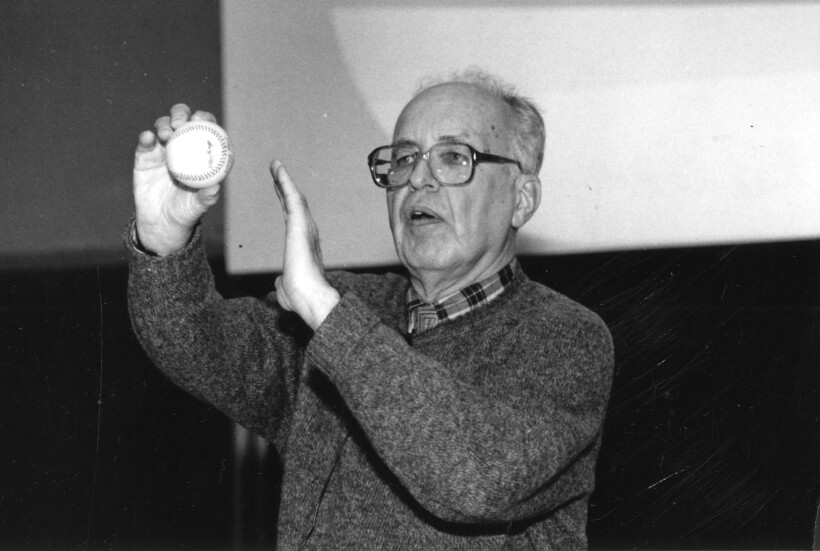
Robert Adair speaking at the Physics of Baseball Colloquium at University of Illinois at Urbana-Champaign.
Department of Physics, University of Illinois at Urbana-Champaign, courtesy AIP Emilio Segrè Visual Archives. Adair Robert B13 .
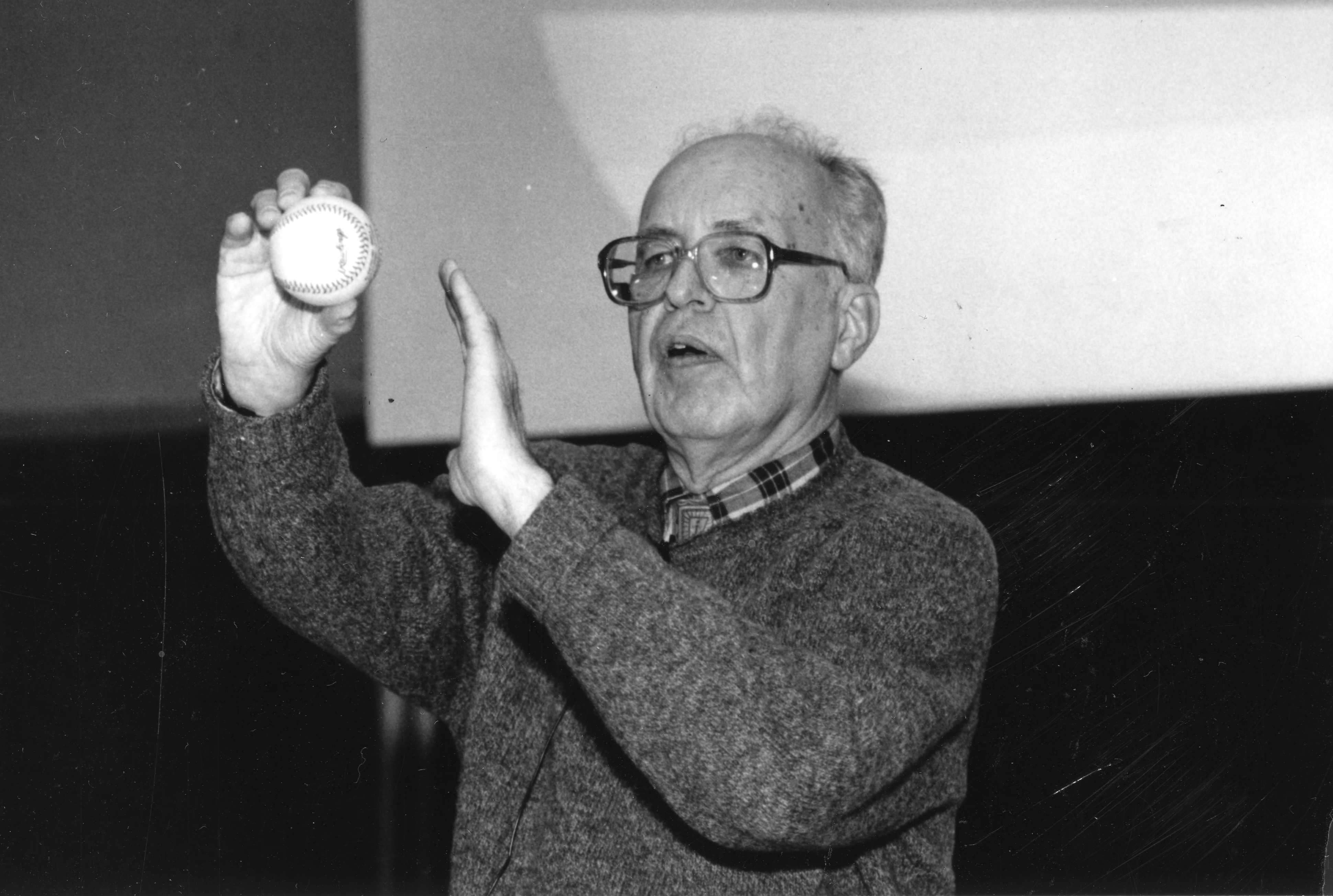
Yale University’s Robert Adair quite literally wrote the book on the physics of baseball. His 1990 The Physics of Baseball became the go-to resource for understanding the game through a scientific lens, from the aerodynamics of a curveball to the sweet spot on a bat. Adair also shared this expertise with Physics Today in this 1995 article summarizing his book. He often shared his insights with the AAPT community and other audiences, making complex concepts like aerodynamics, ball spin, and collision forces accessible to both students and fans. Here, our archives capture him mid-lecture at a Physics of Baseball colloquium at the University of Illinois Urbana-Champaign in his element, translating America’s pastime into equations and experiments.
Alan Nathan
Alan Nathan, an experimental nuclear physicist at the University of Illinois Urbana-Champaign, has spent the past two decades at the forefront of baseball physics research. A frequent speaker for AAPT and other audiences — including at a Physics of Baseball alumni talk held at Wrigley Field where he’s pictured above, Nathan is well known for his accessible demonstrations. Beyond public talks, he maintains a comprehensive The Physics of Baseball website (which helped inform a lot of this blog), and he has advised on everything from Major League Baseball specifications reviews to in-game performance analysis. His work bridges the ballpark and the laboratory, showing how the subtleties of spin, speed, and impact can be measured and understood with scientific precision.
Fieldwork: Physicists at Play
While putting this blog together, I got to learn about the lives and contributions of the late David Kagan and Howard Brody. While these two aren’t in the ESVA, we remember them not just for their enthusiasm for baseball, but for the lasting impact they made on physics education and research. Kagan, an engaged member of both the Society of Physics Students (SPS) and the AAPT, helped generations of students see physics in everyday motion. Brody, too, applied rigorous analysis to the game he loved, producing accessible, insightful studies that connected sport and science. Their legacies live on in the work of physicists like Alan Nathan and Robert Watts, whose current research and books continue to explore the physics of baseball with clarity, curiosity, and joy.
As we’ve seen in these photos, baseball and physics have been connected in some pretty cool ways for a long time. Whether it’s scientists taking a break from their research to play or researchers digging into the science behind the game, there’s a lot to appreciate on and off the field. Today, that connection continues with figures like Alan Roden , the MLB outfielder who brought a physics degree to his 2025 rookie season, and Dr. Meredith Wills , an astrophysicist whose deep dive into the construction of major league baseballs is changing how we understand the sport.
References
- Adair, Robert. The Physics of Baseball. New York: HarperCollins, 1990.
- Adair, Robert. “The Physics of Baseball.” Physics Today, May 1995.
- “This Month in History: March 29, 1959: Lyman Briggs Publishes Research Results on Spin of a Baseball.” APS News, March 29, 2019.
- “Anderson, P. W. Oral history interview by Lillian Hoddeson,” May 10, 1988. American Institute of Physics. .
- Baseball Physics. “Baseball Researchers.” University of Illinois at Urbana-Champaign. .
- Baseball America. Pontes, Geoff. “Meet Alan Roden: The Blue Jays OF With A Physics Degree & Opportunity For An MLB Breakthrough In 2025.” April 3, 2025. .
- Chico State Today. “Fond Farewell to Retired Physics Professor David Kagan.”
- Emilio Segrè Visual Archives, American Institute of Physics. “Alan Nathan Demonstrating the Sweet Spot, Physics of Baseball Alumni Talk at Wrigley Field.” Department of Physics, University of Illinois at Urbana-Champaign.
- Associated Press. “Edison Fells Cobb with Wicked Drive.” Evening Star. (Washington, DC), Mar. 8 1927. .
- John S. Rigden; Editorial: The Melba Newell Phillips Award. Am. J. Phys. 1 December 1985; 53 (12): 1135.
- Lyman J. Briggs; Effect of Spin and Speed on the Lateral Deflection (Curve) of a Baseball; and the Magnus Effect for Smooth Spheres. Am. J. Phys. 1 November 1959; 27 (8): 589–596.
- Nathan, Alan. “The Physics of Baseball.” University of Illinois at Urbana-Champaign. .
- National Institute of Standards and Technology (NIST). “NIST Connections to Baseball.”
- Obituary of Wolfgang K. H. Panofsky. Physics Today, 26 September 2007;
- Lopatka, Alex. “Baseball Rubbing Mud Does in Fact Make Balls.” Physics Today, March 1, 2025.
- Pontes, Geoff. “Meet Alan Roden: The Blue Jays OF With A Physics Degree & Opportunity For An MLB Breakthrough In 2025.” Baseball America, April 3, 2025. .
- University of Osaka. “Hideki Yukawa and The University of Osaka.” .
- Sin‐itiro Tomonaga; Development of quantum electrodynamics. Physics Today, 1 September 1966; 19 (9): 25–32.
- Thomas A. Edison, Inc, and Paper Print Collection. The Ball Game. produced by Heise, Williamuction, Camera United States: Thomas A. Edison, Inc, 1898. Video.


5 Comments
https://shorturl.fm/gv4r3
https://shorturl.fm/646zl
https://shorturl.fm/VwhWh
https://shorturl.fm/e9P5i
https://shorturl.fm/44yjU